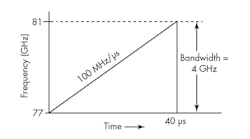Millimeter-Wave Single-Chip Radar Sensors Get Practical (.PDF Download)
Did you know that the single-chip radar system-on-chip (SoC) is becoming one of the most popular new sensors? Its widespread adoption in cars has greatly increased the sales volume, and in turn lowered the price. These sophisticated ICs have become essential to automakers, but they’re also attractive for other applications. And though automotive applications of these ICs will continue to dominate, designers are now exploring a range of new uses that can improve safety and convenience.
Radar ICs
Single-chip radars—who would have thought? Yet they now come in a variety of forms from multiple manufacturers. The chips have been developed for the 24-, 76- to 81-, and 94-GHz bands in most countries. Though both continuous-wave (CW) and pulse types are available, most use the frequency-modulated continuous-wave (FMCW) scheme at 77 MHz. Some of these devices are made with silicon germanium (SiGe), but the latest versions consist of CMOS or BiCMOS. Complete modules for auto or other industrial uses are offered by some companies. Their unique capabilities make them an attractive alternative to other sensors for certain new applications.
Most engineers tend to mentally categorize these devices according to their original use—as a radar system on a chip. However, it’s better to view them as just another type of sensor. Thus, millimeter-wave (mmWave) radars are an unexpected choice when seeking a device for proximity detection of objects, motion sensing, or making physical measurements.
1. This FMCW chirp signal is commonly used in the 76- to 81-GHz band.
Remember, radar is used to measure distance, direction (angle), and speed. Examples include police speed radars and baseball speed guns. A transmitter (Tx) in the chip radiates a signal that’s then reflected from a remote object and returns back to a receiver at the source. The transmitted signal is a linearly increasing frequency change for a short duration, called a chirp (Fig. 1). The chirps are repeated in a desired pattern.

